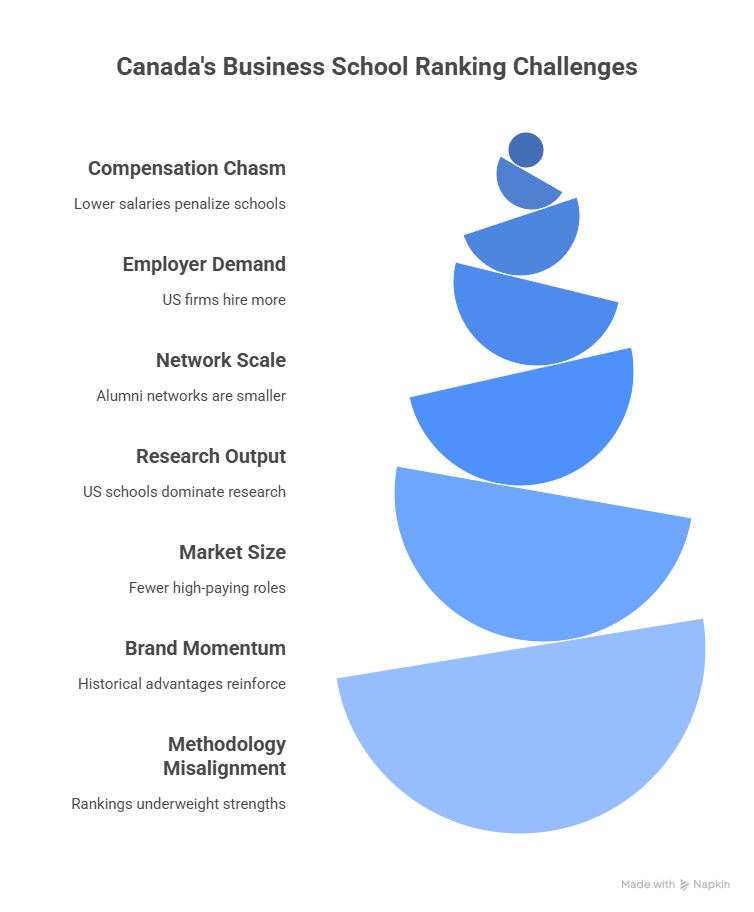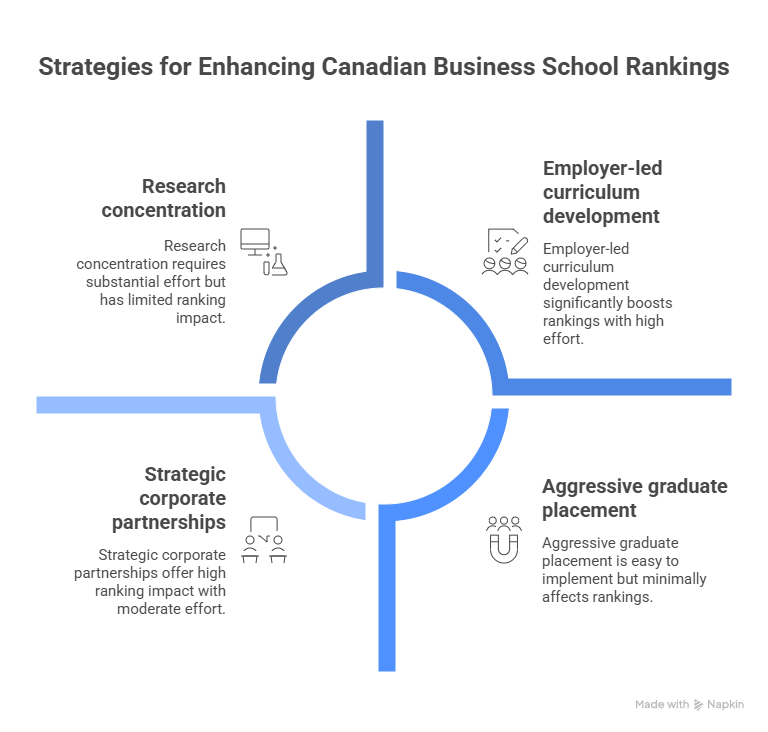The Canadian MBA Ranking Gap: Structural Reality vs. Strategic Opportunity
Oct 25, 2025
The annual MBA rankings reveal a consistent pattern that frustrates ambitious Canadian business students and administrators alike: while Canadian programs deliver exceptional education, they consistently trail their U.S. counterparts in global rankings. The 2025 Financial Times Global MBA Ranking features no Canadian school in the top 50, with HEC Montréal at #51 and Rotman leading other major programs at #52. This positioning isn't an accident—it's the direct result of ranking methodologies that systematically favor structural advantages inherent to the U.S. market.

The Seven Structural Handicaps: Why Canada Starts Behind
- The Compensation Chasm Financial Times allocates approximately 32% of its ranking weight to salary-related metrics—alumni salary three years post-graduation and salary increase. The numbers reveal a stark divide: while top U.S. programs like Stanford and Harvard report median salaries exceeding $185,000 USD, leading Canadian schools cluster between $100,000 and $155,000 CAD. Even after purchasing power parity adjustments, this gap represents a fundamental structural difference that ranking formulas systematically penalize.
- Employer Demand Concentration QS World University Rankings assigns the heaviest weight (40%) to employer reputation, measured through global employer surveys. The U.S. market's density of Fortune Global 500 headquarters (139 companies, approximately 28% of the total) creates a natural advantage. According to available recruitment insights, firms like McKinsey hire from numerous U.S. business schools but fewer Canadian programs, reflecting this concentration effect.
- Network Scale and Geography Bloomberg Businessweek's networking metric rewards programs with massive, concentrated alumni networks in global business hubs. The Greater New York City area alone hosts more Fortune 500 headquarters than all of Canada combined. This geographic concentration creates cluster hiring effects and networking opportunities that even elite Canadian programs cannot match in scale.
- Research Output Disparity Financial Times allocates 10% of its score to research rank, measured by faculty publications in top academic journals. U.S. programs dominate research output: according to the UT Dallas Top 100 Business School Research Rankings 2025, American schools account for the majority of top positions, with the Naveen Jindal School of Management at UT Dallas ranking #1 globally. Canadian faculty produce excellent research but at volumes that cannot compete with better-funded U.S. counterparts.
- Market Size and Role Mix The U.S. simply offers more high-compensation roles in sectors that rankings reward. According to recent data, U.S. programs place around 28% of graduates into consulting roles with median salaries of $165,000 USD, compared to lower percentages in Canada at approximately $115,000 CAD. In private equity, the gap is even more pronounced, with U.S. programs placing three times as many graduates into the sector at nearly double the compensation.
- Brand Momentum Compounds Annually Because many rankings incorporate multi-year data and reputation surveys that change slowly, historical advantages become self-reinforcing. A school's position today is partially determined by its position five years ago. This creates a momentum effect that makes rapid ranking ascension mathematically difficult, regardless of program improvements.
- Methodology Misalignment Canadian programs excel in areas that rankings underweight. According to QS data, Canadian schools significantly outperform U.S. peers in international student diversity (averaging 45% versus 32%) and value for money. However, these categories typically represent less than 15% of total ranking weight, while compensation and employer reputation often exceed 50% combined.

The Strategic Path Forward: Playing a Different Game
Canadian business schools cannot win by simply imitating U.S. programs. Instead, they must leverage unique structural advantages while strategically addressing ranking vulnerabilities.
Immediate Levers for Ranking Impact
First, schools must aggressively channel graduates into high-compensation tracks. Rotman's Finance Lab and Ivey's case-method approach provide strong foundations, but they require sharper focus on placement outcomes that ranking methodologies reward. This means expanding dedicated pipelines into U.S. consulting firms and investment banks, even if it means accepting that some graduates will leave Canada.
Second, employer-led curriculum development represents an underutilized opportunity. By co-designing "AI operator studios" and "PE value-creation labs" with top recruiters, Canadian schools can directly influence the employer reputation surveys that drive QS rankings. The model should mirror Ivey's long-standing corporate partnerships but with explicit ranking metrics in mind.
Third, research concentration offers a path to disproportionate impact. Rather than competing across all business disciplines, Canadian schools should dominate niche areas where they already possess structural advantages—particularly AI operations and climate finance. The Vector Institute's partnerships with Toronto universities provide a template for this focused excellence.
The Alumni Activation Imperative
Networking scores represent one of the most addressable ranking gaps. Canadian programs must implement formal alumni referral programs and success dashboards that systematically demonstrate placement velocity and career trajectory. When 40% of Ivey's 2024 graduating class received offers within 90 days of graduation, that story needs to be told more effectively to ranking survey participants.
The Bottom Line: Reframing Success
The ranking gap between Canadian and U.S. MBAs reflects structural market differences more than educational quality disparities. However, by understanding ranking methodologies with operational precision, Canadian schools can strategically narrow the gap while leveraging their unique advantages in diversity, value, and immigration pathways.
The most successful Canadian programs will be those that stop trying to beat American schools at their own game and start defining a new one—where global talent accessibility, AI integration, and cross-border career mobility become the metrics that matter most. In an era of remote work and global talent redistribution, these may prove to be the most valuable advantages of all.
© VCII 2025 By Tracy Wong (www.vciinstitute.com)
We have many great affordable courses waiting for you!
Stay connected with news and updates!
Join our mailing list to receive the latest news and updates from our team.
Don't worry, your information will not be shared.
We hate SPAM. We will never sell your information, for any reason.


